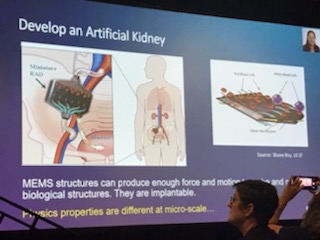With the growing number of intelligent devices (and by “intelligent” I mean: An internet connected device running some form of software that collects and performs actions on data), bringing intelligence to the Edge has become a more pervasive topic of discussion. What is “the Edge?” Computing devices physically located at the point of use running software that is running locally instead of in the cloud. The cloud? Remotely hosted computing services such as storage (think: Google Drive) and infrastructure (virtual machines) — these services depend on a network connection. This sets the stage for the session: Developing Embedded Intelligence: Opportunities on the Edge. It was led by a panelist of experts in the field:
Brenda Zhuong of MathWorks (moderator), Miriam Leeser of Northeastern University, Micheala Blott of Xilinx Research, Mary Ann Maher of SoftMEMS LLC , and Yan Wan from the University of Texas at Arlington.

The high level considerations that were illuminated by the panel of experts were:
- Improving intelligence through data analytics
- Gaining efficiency by taking advantage of the hardware capabilities
- Reducing dependency on the (internet) network by hosting data and services where they will be used.
We then got into some real-world use cases that demonstrate the power of harnessing intelligence at the Edge.
Gain Efficiency in Embedded Intelligence; Michaela Blott

Urban Aerial Vehicle (UAV)-based airborne computing for future Internet of Things; Yan Wan

Developing an Artificial Kidney; Mary Ann Maher

Considerations…
- Seed neural networks with data coming from the actual environment so you can determine when sensors are malfunctioning — not all data is good data.
- Understand power constraints — battery life has been a limitation
- With all of the data being collected, privacy becomes paramount — always encrypting data at rest and in transit.
Some best practices…
If you plan to develop in this space, or are already working on a project, there are methodologies you can put into practice that will improve your solution. Here are a few:
- There is so much sensor data, it is not possible, nor would it be advisable, to send all of it back to the cloud, which means the capability to do some level of analysis at the edge and send only the relevant data to the cloud is
- Take advantage of cloud computing to simulate sensor data to rapidly design but then deploy at the edge.
- Tagging quality data so you can establish a confidence in the sensor data with corresponding visualization (graphical representation) is crucial.
- IoT devices tend not to have as much computing power, leveraging distributed computing models to perform calculations
- Implement redundancy of sensors and computational devices in mission critical systems
Where do we go from here?
Computer vision and artificial intelligence are changing the landscape of computing. We have to improve the accuracy of vision sensors so that the data is reliable. The cost of quality vision sensors is prohibitive at the moment, and before development can really take off, it must come down. Research into correctness proofs is needed to verify algorithms developed for mission critical Edge workloads. Safety, especially for use cases like autonomous driving, is not a 90% correctness solution — it’s okay if your cell phone drops its connection, it is deadly if your car stops in the middle of an intersection. Portable IoT devices like ultrasound and water testing can bring life-saving technology to network constrained environments, and have the potential to revolutionize medicine.
The panelists were asked to make predictions for the next three years in Edge Intelligence (If any of these things come to pass, you heard it here first!) Some of them being:
- Speech recognition as a human computer interface will become much more prevalent
- Facial recognition will be integrated into more technology
- Deployments of sensors and devices in rural areas will help to eradicate diseases
- More innovative hardware platforms for IoT use cases
Recommended reading: